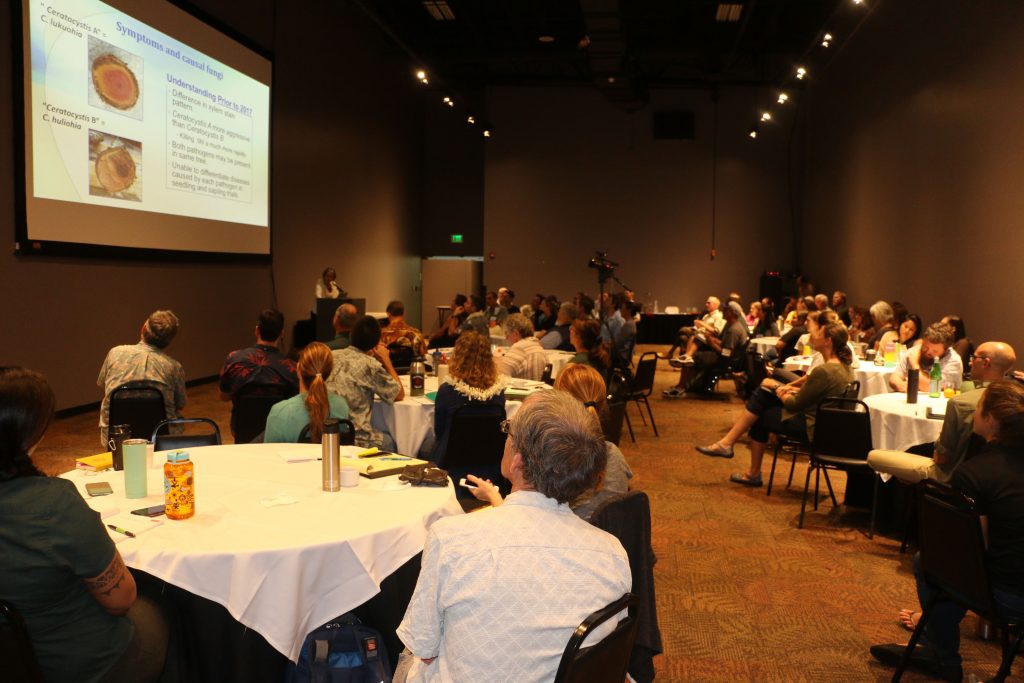05/31/19-LATEST SCIENTIFIC RESEARCH & NEXT STEPS REVEALED IN BATTLE AGAINST RAPID ʻŌHIʻA DEATH
Posted on May 31, 2019 in Forestry & Wildlife, sliderNews Release
| DAVID Y. IGE GOVERNOR |
SUZANNE D. CASE
CHAIRPERSON |
For Immediate News Release: May 31, 2019
LATEST SCIENTIFIC RESEARCH & NEXT STEPS REVEALED IN BATTLE AGAINST
RAPID ʻŌHIʻA DEATH
First-Ever Rapid ʻŌhiʻa Death Science Symposium Held
To view video please click on photo or view at this link: https://vimeo.com/339638407
(Hilo) – This week top scientists and managers engaged in the fight against Rapid ʻŌhiʻa Death shared knowledge, their latest research findings, and discussed next steps in battling the fungal disease that has killed millions of ʻōhiʻa trees, primarily on Hawai‘i Island, but also on a much more limited scale on Kaua‘i.
The first-ever Rapid ʻŌhiʻa Death Science Symposium at the ‘Imiloa Astronomy Center of Hawai‘i on the UH-Hilo campus included two days of scientific presentations followed by a half-day workshop with the goal of identifying the next research questions to hopefully and ultimately identify treatments for the two strains of the disease. So far extensive aerial and ground surveys have not shown it spreading beyond Kaua‘i or Hawai‘i Island.
In a keynote address to more than 90 top researchers and land managers working on the disease, DLNR Chair Suzanne Case said, “Thank you all for the incredibly hard work you’ve been doing these last few years on all fronts; from identifying the causes of Rapid ʻŌhiʻa Death, to mapping its distribution and learning about how it spreads. Experimenting with ways to contain it and all the outreach and education so everyone in Hawai‘i can know how not to spread it further. Your work is necessarily innovative and often ingenious because we’ve never encountered these pathogens, nor their effect on our beloved ʻōhiʻa forest.”
Intensive research into exactly how Rapid ʻŌhiʻa Death spreads and potential treatments has been underway, nearly since the fungus was first detected as a previously un-described disease in 2014.
Scientists have determined that the fungus enters ʻōhiʻa trees and interrupts their vascular systems which means water can’t move from the roots and into higher reaches of the trees. They also know that the disease enters individual trees through wounds that can be caused by wind or hurricane events, by animals, weed-eaters, heavy equipment, pruning and trimming. What’s less clear and is the subject of continuing research is how does the fungus spread from tree to tree and what are the best methods for treating infected trees to try and stop additional infections?
While the scientific research being conducted by numerous federal agencies and academic institutions, coupled with management protocols established by state and county agencies has led to an enormous body of knowledge about these emerging diseases, Rapid ʻŌhiʻa Death continues to be shrouded in mystery. Where did it first come from? Why does it infect some trees and not others? Does the wind carry fungal spores and if so why did it skip over Maui Nui and O‘ahu before being first detected on Kaua‘i a year ago?
The group also looked at the efficacy of current methods to try and stem the spread of Rapid ʻŌhiʻa Death. Do boot cleaning stations at trailheads work? Does felling, tarping, and fungicide application to dead trees stop the fungus in its tracks? Are additional quarantine measures needed to strengthen those already in place to provide an additional layer of protection to uninfected trees? And, what additional outreach and education needs to happen to best inform everyone about Rapid ʻŌhiʻa Death and how it is devastating hundreds of thousands of acres of ʻōhiʻa forest – ʻōhiʻa is considered Hawaii’s most important native tree species because of its watershed protecting abilities and cultural significance.
Following DLNR Chair Case’s opening remarks Kumu Kekuhi Keali’ikanaka’olelohaililani of Hālau ʻŌhiʻa implored the scientists, managers, and everyone who cares for Hawaii to embrace the ʻōhiʻa lehua as a vital component of our natural landscape and cultural heritage. She told the group, “You’ve done your job to create this collaborative, this collective movement. Ritual practices taught me that your imaginings are the experimentation, is the meetings, is the movement, the working together and the innovative approaches.”
# # #
Media Contact:
Dan Dennison
Senior Communications Manager
(808) 587-0396
[email protected]
